Brooks, OC ’70, Returns to Oberlin
Assistant Professor of Theater Justin Emeka, OC ’95, interviews Avery Brooks, OC ’70, in Finney Chapel Saturday night. Brooks treated the audience to soulful music on the piano and a monologue from ‘Othello,’ and, at his request, the convocation concluded with two student performances.
February 28, 2014
Actor Avery Brooks, OC ’70, came onstage at Finney Chapel in an all-white suit, took a seat at the piano, and treated the audience to a dramatic performance of “Throw it Away” by jazz singer and songwriter Abbey Lincoln — an unorthodox beginning to an unorthodox convocation. However, the event was thoroughly consistent with the interpretation of the word “convocation” as “a celebration”; Brooks’s convocation, though unusual, was foremost a celebration of art and community.
Currently, Brooks is a professor of Theater Arts at Rutgers University, but, more famously, he is an actor, musician and director best known for his roles as Captain Sisko on Star Trek: Deep Space Nine and Detective Hawk on Spenser: For Hire. Brooks has also acted in American History X and twenty years ago played Solomon Northup in the PBS movie Half Slave Half Free based on the memoir Twelve Years a Slave. In his introduction to Brooks’s convocation, President Krislov quoted Brooks as saying, “Brown children must be able to participate in traditional mythology.” In his convocation, Brooks followed the theme of mythology, calling it “one of the most important tools man has been given.” His interest in integrating the perspectives and aesthetics of people of all races into typically Western mythology and culture was evident; one of the first things he said was, “Every single moment depends on us coming together.”
During the convocation, Brooks talked to Assistant Professor of Theater Justin Emeka, OC ’94, whose friendship with Brooks began when they met twenty years ago. When Emeka asked Brooks about his experience at Oberlin, Brooks spoke eloquently of coming to the haven of liberalism during the turbulent 1960s. His grandmother had tried to come to Oberlin but couldn’t afford it, so Brooks was determined to attend with a scholarship. When he finally matriculated, he was part of the largest class of people of color in the school’s history. Brooks then went on to discuss his experience with an art and performance collective that performed to audiences outside the Oberlin College bubble. His desire to bridge the town-gown divide, Brooks said, was due to his experience growing up in a community where everyone knew each other.
Bridging the “proverbial walls” between communities was a recurring theme of the convocation and apparently one of Brooks’s major artistic goals. For example, when asked about how he identifies a piece of art as “classical,” Brooks said that the most important consideration is that the work must be universally appealing, transcending time and location. He disputed the notion that a “classic” has to be inaccessible. To refute this, he referenced Shakespeare, who was so dedicated to capturing the vernacular of the people in his plays that he didn’t even use punctuation in the original editions, as an example of an accessible classical artist.
Remarkably, Brooks answered many of Emeka’s questions using art — he often walked over to the piano for another impassioned rendition of “Throw it Away,” his music serving as his only answer to the question. His voice was gripping and emotionally evocative, and his theater training showed in his ability to speak with his hands and modulate his tone of voice to keep the audience enthralled.
Brooks emphasized the interconnectedness of time and space at Oberlin today. However, he said that Oberlin should work harder to help students feel hopeful about what they will do after graduation, particularly those interested in pursuing artistic fields. He emphasized that he couldn’t imagine that the events leading up to March 4 last year would have happened at the Oberlin of 1966. Though there was certainly political strife on campus then, Brooks said that there was no question that students shouldn’t blatantly disrespect each other’s identities. However, he stressed that we have a responsibility to keep the story of March 4 alive: “We can’t solve it, but we sure can talk about it.”
At both the beginning and end of the convocation, Brooks asked audience members to name one person who had helped them to get here — their parents, the people who had driven them to Finney or any other person who had helped them along in life. At the end of the convocation, Brooks gave a stunning rendition of a Othello’s dying speech from Shakespeare’s Othello, the way he said Paul Robeson ended his public appearances. Then, in keeping with his perception of a convocation as a celebration — of life, of art and of community — he invited College sophomore Caylen Bryant to the stage. Bryant had played her original cello song “To the Mountaintop” at the tribute to Brooks the previous night, which Brooks said truly touched him, and Bryant performed it again at Brooks’s request, followed by an energetic dance performance by Dance Diaspora. “It’s not a holiday,” he’d said earlier, “but you can declare one whenever you want.” And declare a holiday was exactly what Brooks did.




















